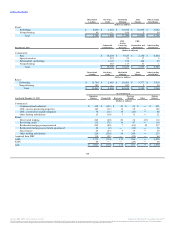BB&T 2014 Annual Report Download - page 102
Download and view the complete annual report
Please find page 102 of the 2014 BB&T annual report below. You can navigate through the pages in the report by either clicking on the pages listed below, or by using the keyword search tool below to find specific information within the annual report.
Table of Contents
BB&T uses the long-haul method to assess hedge effectiveness. BB&T documents, both at inception and over the life of the hedge, at least quarterly, its
analysis of actual and expected hedge effectiveness. This analysis includes techniques such as regression analysis and hypothetical derivatives to
demonstrate that the hedge has been, and is expected to be, highly effective in off-setting corresponding changes in the fair value or cash flows of the hedged
item. For cash flow hedges involving interest rate caps and collars, this analysis also includes consideration of whether critical terms match, the strike price of
the hedging option matches the specified level beyond (or within) which the entity’s exposure is being hedged, the hedging instrument’s inflows (outflows)
at its maturity date completely offset the change in the hedged transaction’s cash flows for the risk being hedged and the hedging instrument can be exercised
only on its contractual maturity date. For a qualifying fair value hedge, changes in the value of the derivatives that have been highly effective as hedges are
recognized in current period earnings along with the corresponding changes in the fair value of the designated hedged item attributable to the risk being
hedged. For a qualifying cash flow hedge, changes in the fair value of the derivatives that have been highly effective are recognized in OCI until the related
cash flows from the hedged item are recognized in earnings. For qualifying cash flow hedges involving interest rate caps and collars, the initial fair value of
the premium paid is allocated and recognized in the same future period that the hedged forecasted transaction impacts earnings.
For either fair value hedges or cash flow hedges, ineffectiveness may be recognized to the extent that changes in the value of the derivative instruments do
not perfectly offset changes in the value of the hedged items. If the hedge ceases to be highly effective, BB&T discontinues hedge accounting and recognizes
the changes in fair value in current period earnings. If a derivative that qualifies as a fair value or cash flow hedge is terminated or the designation removed,
the realized or then unrealized gain or loss is recognized in income over the life of the hedged item (fair value hedge) or in the period in which the hedged
item affects earnings (cash flow hedge). Immediate recognition in earnings is required upon sale or extinguishment of the hedged item (fair value hedge) or if
it is probable that the hedged cash flows will not occur (cash flow hedge).
Derivatives used to manage economic risk not designated as hedges primarily represent economic risk management instruments of MSRs and mortgage
banking operations, with gains or losses included in mortgage banking income. In connection with its mortgage banking activities, BB&T enters into loan
commitments to fund residential mortgage loans at specified rates and for specified periods of time. To the extent that BB&T’s interest rate lock commitments
relate to loans that will be held for sale upon funding, they are also accounted for as derivatives, with gains or losses included in mortgage banking income.
Gains and losses on other derivatives used to manage economic risk are primarily associated with client derivative activity and are included in other income.
Credit risk resulting from derivatives arises when amounts receivable from a counterparty exceed those payable to the same counterparty. The risk of loss
with respect to over-the-counter derivatives, eligible margin loans and repurchase-style transactions is addressed by subjecting counterparties to a credit
review and approval process similar to the process in making loans or other extensions of credit and/or by requiring collateral.
Derivative dealer counterparties operate under agreements to provide cash and/or highly liquid securities on a daily basis for unsecured credit exposure
beyond negotiated limits, while client derivatives that are associated with loans are cross-collateralized with the loan.
BB&T only transacts with dealer counterparties that are national market makers with strong credit standings and requires liquid collateral to secure credit
exposure. Due to these factors, the fair value of derivatives with dealer counterparties is primarily based on the interest rate mark of each trade. The fair value
of interest rate derivatives with clients includes a credit valuation adjustment.
Collateral obtained to secure margin loans includes equities, corporate and municipal securities, and repurchase-style transactions are generally secured by
government and agency securities. The value of collateral for margin loans and repurchase-style transactions is monitored daily with settlement required
when changes in value exceed established limits by counterparty. Due to the liquid nature of collateral, the frequency of transactions and collateral
monitoring, a reserve for credit loss is established only when a risk of loss is identified.
101
Source: BB&T CORP, 10-K, February 25, 2015 Powered by Morningstar® Document Research℠
The information contained herein may not be copied, adapted or distributed and is not warranted to be accurate, complete or timely. The user assumes all risks for any damages or losses arising from any use of this information,
except to the extent such damages or losses cannot be limited or excluded by applicable law. Past financial performance is no guarantee of future results.
























